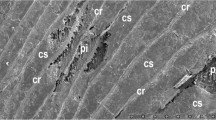Summary
The three-dimensional organization of the canal system in two sponge species, Petrosia ficiformis and Chondrosia reniformis, was studied using corrosion casts. Casts were made of live animals, in situ, and canal replicas were analzyed by scanning electron microscopy (SEM). In P. ficiformis the incurrent system consists of a superficial canal network giving rise to large radial canals, which ramify and anastomosize forming an internal web. Excurrent canals are arranged into modular ramified systems radiating from atrial cavities opening to the exterior. Main excurrent canals run at various depths within the sponge, even through the superficial incurrent network. Both incurrent and excurrent canal replicas show smooth, blind-ending capillaries. Some large incurrent canals merge with excurrent ones, thus bypassing choanocyte chambers. In C. reniformis there is a cortical collagen layer crossed by three-like incurrent canals, the “twigs” of which communicate with groups of inhalant pores. The stems of tree-like canals penetrate into the sponge medulla where they ramify and anastomosize to form a web. Main excurrent canals arise from large cloacal ducts leading to the oscular openings. They give rise to a sequence of branches intersecting the incurrent web. Both incurrent and excurrent canals have sharp, blind-ending capillaries. Morphometric data functions show that diameter scaling in canal branches is exponential in Petrosia and linear in Chondrosia. Structural differences and homologies between the two species are discussed.
Similar content being viewed by others
References
Brien P (1973) Les Demosponges. In: P P Grassé (ed) Traité de Zoologie, vol III, part 1. Masson, Paris, pp 133–461
De Vos L (1979) Structure tridimensionelle de l'éponge Ephydatia fluviatilis. In: Levi C, Boury-Esnault N (eds) Biologie des spongiaires. Colloq Int CNRS Paris 291:159–164
Ditrich H, Splechtna H (1987) Scanning electron microscopy of vascular corrosion casts in comparative studies on renal vascular structure. Scanning Microscopy 1:1339–1347
Langenbruch PF (1983a) Body structure of marine sponges: I. Arrangement of the flagellated chambers in the canal system of Reniera sp. Mar Biol 75:319–325
Langenbruch PF (1983b) Untersuchungen zum Körperbau von Meeresschwämmen: II. Das Wasserleitungssystem von Halicondria panicea. Helgoländer Meeressunters 36:337–346
Langenbruch PF, Scalera Liaci L (1986) Body structures of marine sponges: IV. Aquiferous system and choanocyte chambers in Haliclona elegans (Porifera, Demospongiae). Zoomorphology 106:205–211
Langenbruch PF, Simpson TL, Scalera Liaci L (1985) Body structure of marine sponges: III. The structure of choanocyte chambers in Petrosia ficiformis (Porifera, Demospongiae). Zoomorphology 105:383–387
Langenbruch PF, Weissenfels N (1987) Canal system and choanocyte chambers in freshwater sponges (Porifera, Spongillidae). Zoomorphology 107:11–16
Reiswig H (1975) The aquiferous system of three marine Demospongiae. J Morphol 145:493–502
Simpson TL (1984) The cell biology of sponges. Springer, Berlin Heidelberg New York
Schulze FE (1877) Bau und die Entwicklung der Spongien. Die Familie Chondrosidae. Engelmann, Leipzig
Vogel S (1974) Current-induced flow through the sponge Halichondria. Biol Bull 147:443–456
Weibel ER, Gomez DM (1962) Architecture of the human lung. Science 137:577–585
Weissenfels N (1975) Bau und Funktion des Süßwasserschwamms Ephydatia fluviatilis L. (Porifera): II. Anmerkungen zum Körperbau. Z Morphol Tiere 81:241–256
Weissenfels N (1976) Bau und Funktion des Süßwasserschwamms Ephydatia fluviatilis L. (Porifera): III. Nahrungsaufnahme, Verdauung und Defäkation. Zoomorphology 85:73–88
Weissenfels N (1982) Bau und Funktion des Süßwasserschwamms Ephydatia fluviatilis L. (Porifera): IX. Rasterelectronenmikroskopische Histologie und Cytologie. Zoomorphology 100:75–87
West BJ, Bhargava V, Goldenberger AL (1986) Beyond the principle of similitude: renormalization in the bronchial tree. J Appl Physiol 60:1089–1097
Author information
Authors and Affiliations
Rights and permissions
About this article
Cite this article
Bavestrello, G., Burlando, B. & Sara', M. The architecture of the canal systems of Petrosia ficiformis and Chondrosia reniformis studied by corrosion casts (Porifera, Demospongiae). Zoomorphology 108, 161–166 (1988). https://doi.org/10.1007/BF00363932
Received:
Issue Date:
DOI: https://doi.org/10.1007/BF00363932




